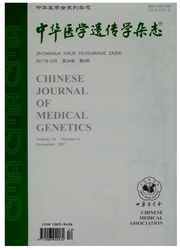

 中文摘要:
中文摘要:
目的建立凝血因子Ⅷ(factorⅧ,FⅧ)基因剔除小鼠模型,为研究治疗血友病A提供理想的动物模型。方法应用ET克隆、胚胎干细胞同源重组和四倍体囊胚补偿技术,将小鼠F阿基因第16~19外显子靶向剔除,并应用PCR、逆转录PCR(reverse transcriptase-PCR,RT-PCR)及免疫组织化学染色技术,从DNA、RNA、蛋白水平检测FⅧ基因的转录及表达情况。通过检测激活的部分凝血活酶时间(activated partial thromboplastin time,APTT)和FⅧ的促凝活性(FⅧ:C)进行FⅧ基因剔除小鼠表型鉴定。结果PCR检测在剔除小鼠中未扩增出FⅧ基因的条带;RT—PCR分析显示剔除区域该基因mRNA转录本缺失;免疫组织化学染色显示在雄性半合子(-/y)和雌性纯合子(-/-)小鼠的肝脏中凝血因子Ⅷ表达缺失;FⅧ:C和APTT检测结果显示雌性杂合子(+/-)FⅧ活性为野生型(wt)的80%,其APTT值较wt略有延长,而-/y和-/-小鼠的FⅧ的活性仅为wt小鼠的8%和10%,且APTT值均大于120s。结论FⅧ基因剔除小鼠具有与人类血友病A患者相似的表型,它的建立将促进我国血友病A治疗新技术的发展。
 英文摘要:
英文摘要:
Objective Factor Ⅷ ( FⅧ) gene knockout mouse model was established for further study on the treatment of hemophilia A. Methods Exons 16-19 of the mouse F Ⅷ gene were knocked out by ET clone, ES homologous recombination and tetraploid embryo compensation technology. PCR, reverse transcriptase-PCR (RT-PCR) and immunohistochemistry were used to detect the transcription and translation pattern of FⅧ. The phenotype of the knockout mice was analyzed by examining the activated partial thromboplastin time (APTT) and FⅧ activity (F Ⅷ: C). Results PCR, RT-PCR and immunohistochemistry confirmed that F Ⅷ was deficient in the F Ⅷ gene knockout mouse. The APTT results showed that F Ⅷ-dcficient mouse plasma had a prolonged clotting time compared to normal mouse plasma. The F Ⅷ : C in heterozygous, hemizygous and homozygous mice was 80%, 8% and 10% of that in normal mice, respectively. Conclusion The phenotype of the F Ⅷ gene knockout mouse appears grossly similar to that of human with hemophilia A. Establishment of this model may promote the development of new technologies of treatment to hemophilia A.
 同期刊论文项目
同期刊论文项目
 同项目期刊论文
同项目期刊论文
 期刊信息
期刊信息
